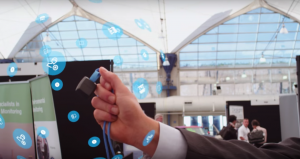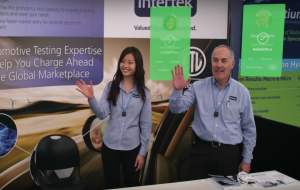Event organizers are always on the lookout for technology that can help them improve the experience of those in attendance. While the addition of interactive content stations, digital smart walls, and QR-codes are still highly desirable features, those planning for the events of tomorrow know they need to branch out. And, one of the newer technologies making waves within the event landscape is beacons.
Beacon technologies provide the benefits of proximity-based engagement strategies with more finesse than simple GPS-oriented technologies and with greater range than traditional RF options. They connect to devices via a Bluetooth variant, often referred to as Bluetooth Low Energy (BLE), Bluetooth 4.0, or Bluetooth Smart.
The beacon is a low-cost device that serves solely as a source of a signal transmission, but that signal is designed to interact with specific apps within an attendee’s smartphone, prompting them to take certain actions or providing them with relevant information.
But, you can’t just put up beacons without a larger plan for how they will provide value to those visiting your event site. Simply using them as glorified pop-up ads will likely create more frustration amongst attendees than enjoyment, and won’t work to make your event any more dynamic than it would be without it. To help you get the most of the beacon technology, here are some tips to help you engage those in attendance in new and exciting ways.
Speed Up the Check-In Process
One of the least desirable parts of any event is the process of checking in. Though streamlining the registration process has received a lot of attention, being stuck in line when entering an event has seen little advancement. And, being forced to wait in line is a significant pain point for those visiting an event. However, if you can integrate the registration process with an event-oriented app, prompting participants to download it before the event, you can use a beacon to speed up the otherwise tedious check-in process.
As attendees approach the entrance, place a beacon in the welcome area. Once the device is detected, the app can prompt the user to check-in remotely. If you want to take it further, you can connect this process to onsite self-service terminals designed to print badges and provide pertinent information without the attendee having to spend nearly as much time as they would with a less automated process.
This creates a strong entrance into your event, as everyone’s initial impression is one of efficiency and accessibility. Just keep staff nearby for those who have additional questions.
Think Gamification
Gamification is another concept that has gained significant traction over the past few years. It involves taking concepts from traditional video game mechanics and applying them to other activities. For example, creating completion bars to help attendees track whether they have experienced everything the event has to offer is gamification at work. So is the additional of challenges, like scavenger hunts, as well as progressing through a prescribed narrative.
Beacons can be used to track an attendee’s progress through an event, as well as a method for directing their behavior. If you want visitors to reach every corner of the event space, then creating a completion bar or scavenger hunt, where each step is completed by getting close enough to a particular beacon, can encourage more exploration into the event space.
Ultimately, these techniques work because gamification encourages a level of fun while also giving attendees a challenge or goal to meet. And, when it comes down to it, who doesn’t want to receive a badge for accomplishing a task?
Encourage Networking
Most events are opportunities to network with like-minded professionals, cutting edge service providers, or other informational sources. But, not everyone is as equipped to take advantage of organic networking opportunities in the same way especially during large events that cover multiple specialty areas.
Beacons can be used to connect attendees to the people and services in which they would have the most interest. For example, visitors can complete profiles before the event that indicates their key areas of interest. Then, as they proceed through the event, beacons can alert them when they are near booths that have the information they want, or within the range of other attendees who share similar interests. Add a method for exchanging contact information through the app, and you have created a simplified networking experience that can benefit participants and those providing information alike.
Improve Navigation and Utilize Real-Time Heat Mapping
Large events and tradeshows can be disorienting. While most event apps help by providing maps of the space, adding beacons can help attendees track where they are and get directions to their chosen destination. Attach these to internal schedules, such as breakout sessions that the visitor expressed interest in, and the beacons can provide time-sensitive information about sessions about to begin and directions to get there.
On the event coordinator side, heat mapping can alert teams when specific areas have become overcrowded, allowing for creative intervention to keep the crowd moving more favorably. For example, if a particular booth has a substantial line, then a beacon can alert nearby attendees to events in other areas that may be of interest. This helps visitors gain information they want while preventing bottlenecks caused by overcrowding.
Triggered Content Delivery
Many event attendees are interested in gathering information from session hosts and tradeshow booths. However, waiting to get physical copies of documents or putting an email address on a list and waiting for delivery isn’t necessarily ideal. Instead, by employing the use of beacons, information can be provided automatically when visitors are within proximity of an event or booth. Automatic delivery can be designed for those attending sessions or meetings, while a download prompt can be displayed in other information areas where proximity to the beacon may be a coincidence.
Delivery methods can also be customized for the event or by the attendee. For example, you can give visitors the option of receiving documents straight through their mobile device or via email, giving them more control. Or, for cases when physical materials may be ideal, connect the service to a nearby self-service terminal, allowing attendees to print information on-site at their convenience.
And More
Any event function that can benefit from location-based alerts or interaction may be appropriate uses for beacons. Anything from lunch menus as attendees near food service locations to charging station alerts if the battery level is detected to be below a certain point may be excellent uses of beacon technology.
Simply consider anything you would like to know when you get close to an area, and see if you can coordinate a beacon to deliver that information in a seamless fashion. Then, attendees can get the equivalent of an expert guided tour that has been customized based on their ideal experience without having to wait in a single line. In the end, through the skilled use of beacons, you can create an event experience unlike any other.
Featured Image credit: 3 Pillar Global
Catherine Reed
Latest posts by Catherine Reed (see all)
- Increase Your Event’s Social Presence by Creating Photo-Worthy Moments - March 6, 2020
- How to Make the Most of Content Production Opportunities at Events - March 3, 2020
- Is Your WiFi Ready for Live-Streaming? - April 25, 2019



